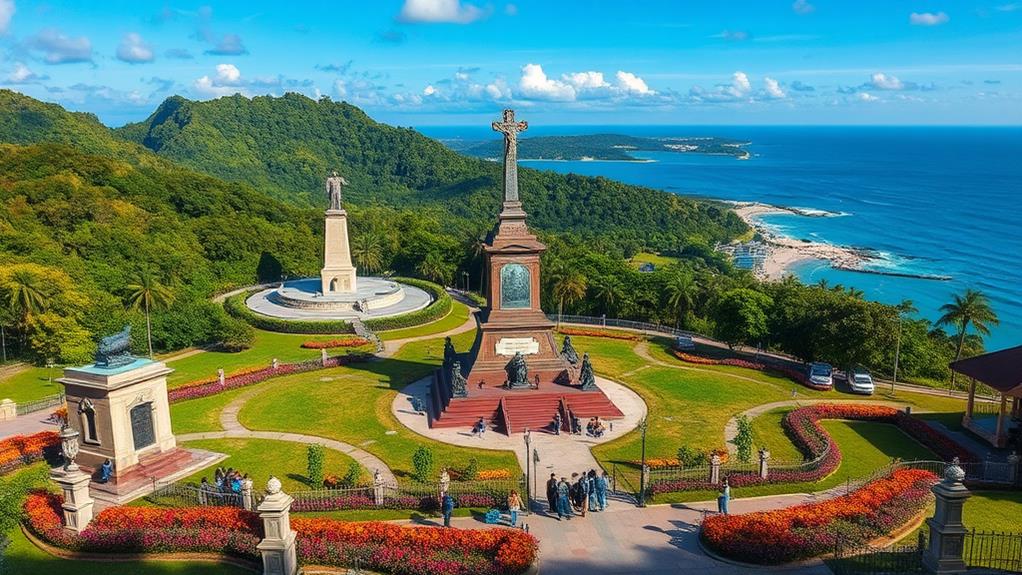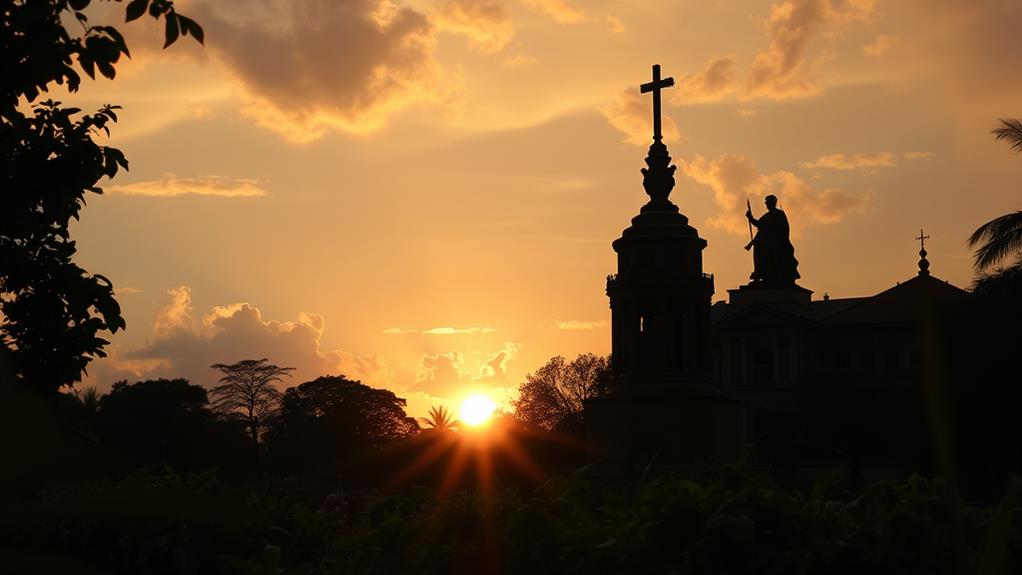The Philippines' Rizal Monuments Showcase National Pride and Identity
Jose Rizal's contributions to freedom and nationalism are commemorated in various monuments across the Philippines. The first Rizal monument was unveiled in Daet in 1898, setting a precedent for the numerous tributes that would follow.
These monuments, found in places like Jolo and Rizal Park in Manila, serve as more than just tributes to Rizal's legacy. They are vibrant community hubs that engage locals and visitors alike, fostering a sense of national identity and pride.
Exploring these landmarks provides a glimpse into Rizal's enduring legacy and the shared cultural narrative of the Philippines.
Dapitan, in particular, holds historical significance, as it was a place where Rizal's contributions to freedom and nationalism left a lasting impact.
By examining these monuments, one can gain a deeper understanding of Rizal's role in shaping the Philippines' national identity.
His legacy continues to inspire Filipinos today, and these monuments stand as testaments to his enduring impact on the country's history and culture.
Rizal's Commemoration and Legacy

Jose Rizal is a prominent national hero in the Philippines, symbolizing freedom and nationalism. He is honored through monuments that remind people of his ideals and contributions. For instance, the first Rizal monument in Camarines Norte, unveiled on December 30, 1898, serves as a tribute to his life and the community's commitment to preserving history.
Rizal Day is a focal point for local celebrations, bringing people together to reflect on his enduring influence. The Bantayog Festival in April is significant, allowing the community to engage with Rizal's legacy in a lively, educational atmosphere. This festival fosters a deeper understanding of his role in shaping Philippine identity and inspires pride in local heritage.
Rizal's legacy extends worldwide, with monuments dedicated to him in various countries. These monuments showcase his universal appeal and the global recognition of his ideals.
Through ongoing educational initiatives, communities continue to promote awareness of Rizal's contributions. This ensures that future generations appreciate the historical context of his struggle for freedom and the importance of civic responsibility.
The First Rizal Monument in Daet
The First Rizal Monument in the Philippines was unveiled in Daet on December 30, 1898. This monument stands as a testament to the early recognition of Jose Rizal's contributions to the nation. The 20-foot tall historical landmark features a three-tiered, triangular design, adorned with engravings of stars, Rizal's name, and the titles of his novels.
The monument was primarily led by Lt. Colonels Antonio Sanz and Ildefonso Alegre of the Revolutionary Army, with local financial contributions from the province. Daet was the first province to celebrate Rizal Day, showcasing its commitment to honoring this national hero.
The monument symbolizes the pride of the Bicolano people and serves as a reminder of their role in shaping Philippine history. Declared a historical landmark by the National Historical Commission in 1961, it continues to inspire future generations.
The monument reflects the values and aspirations of the Filipino people during a pivotal time in their journey toward independence. Visiting this site allows you to connect with a rich legacy and appreciate the grassroots efforts that commemorated Rizal's profound impact on the nation.
The monument encapsulates the spirit of nationalism and unity that Rizal espoused, reflecting the values and aspirations of the Filipino people during a critical period in their history.
Monumental Sites in Jolo

The Rizal Monument in Jolo: A Symbol of National Pride
The Rizal monument in Jolo is a historical site dedicated to honoring the national hero, Jose Rizal. Established within Plaza Rizal, a location steeped in history, it stands proudly amidst a walled city built in 1876 as a Spanish garrison. This site underscores the region's narrative, with landmarks like the Catholic Cathedral and Notre Dame schools nearby, enhancing its cultural relevance.
Security Concerns and Tourism Impact
Security concerns have limited tourism in Jolo, impacting access to information about the monument and the plaza. Despite these challenges, the Rizal monument remains a powerful symbol of national pride, representing Rizal's enduring legacy and his contributions to the Philippines' fight for freedom.
The Significance of the Rizal Monument
As you explore Plaza Rizal, the Rizal monument invites you to understand the intricate tapestry of Jolo's past. It represents the values Rizal espoused, inspiring generations to appreciate their heritage. By reflecting on the historical significance of this site, you can foster a deeper connection to the cultural identity that Rizal embodied.
Exploring Plaza Rizal
When visiting Plaza Rizal, consider the historical context and significance of the site. Take a moment to reflect on the region's narrative, exploring the walled city, the Catholic Cathedral, and Notre Dame schools. This will provide a deeper understanding of Jolo's cultural identity and the enduring legacy of Jose Rizal.
Dapitan: A Historical Shrine City
Dapitan: A City Steeped in History
Dapitan is a city deeply intertwined with the legacy of Jose Rizal, the Philippines' national hero. Rizal was exiled to Dapitan on July 17, 1892, and his experiences during this period significantly shaped his contributions to Philippine history.
The Rizal Shrine: A Testament to History
The Rizal Shrine, covering a sprawling 16-hectare estate, serves as a major tourist attraction. It's home to numerous memorabilia that narrate Rizal's life and ideals.
Approximately 300,000 visitors have flocked to the shrine since 2005, eager to learn about Rizal's life and legacy.
Commemorating Rizal's Arrival
The Disembarkation Site Monument is a testament to Dapitan's historical significance.
Statues of Rizal alongside Spanish sentinels commemorate his landing in Dapitan, symbolizing a pivotal moment in Philippine history.
Beyond History: A Serene Environment
Dapitan's charm lies not only in its rich past but also in its serene environment.
Lush greenery and stunning views of Dapitan Bay provide tranquility, making it an ideal retreat for those seeking solace amidst history.
Modern Attractions
Beyond the Rizal sites, Dapitan offers modern attractions like the Rizaliana Museum and Dakak Beach Resort, enhancing its appeal to tourists.
Whether you're drawn by history or leisure, Dapitan invites you to immerse yourself in its unique blend of past and present.
Rizal Park's Historical Significance

Rizal Park, a 58-hectare expanse in the heart of Manila, is a powerful symbol of Philippine history and national identity. The park is the site of Jose Rizal's execution on December 30, 1896, which ignited the Philippine Revolution against Spanish rule.
Rizal Monument is a bronze-and-granite tribute to Rizal that features engravings of his name and the titles of his novels, embodying national pride and heritage. This monument is a constant reminder of Rizal's significance in Philippine history.
The park has played a significant role in shaping the nation's political landscape. The declaration of Philippine independence on July 4, 1946, and the People Power Revolution of 1986 were two significant events that took place in the park.
These events demonstrate the park's importance in the country's struggle for freedom and democracy.
Rizal Park is also a cultural hub that houses educational institutions, including the National Museum Complex and the National Planetarium. These institutions enhance the park's cultural significance and provide a space for learning and exploration.
The park serves as a constant reminder of the sacrifices made for freedom, inviting reflection on the nation's past and future.
The Philippine Revolution and the struggles of Jose Rizal are just a few examples of the sacrifices that are remembered and honored in the park.
Do Any Samar Caves Feature Historical Ties Similar to Rizal Monuments?
The Philippines is rich in history, with landmarks like Rizal Monuments symbolizing national pride. Certain Samar cave adventures offer a glimpse into the past as well, with caves serving as sites of ancient settlements or resistance hideouts. Exploring these caves reveals not just natural wonders but also echoes of historical significance.
Cultural Impact and Community Engagement
Jose Rizal's Legacy Extends Beyond Rizal Park
Jose Rizal's impact is felt throughout the Philippines, with various monuments and community activities that showcase his significance. In Daet, the first Rizal monument is a powerful symbol of national pride and historical importance, reinforcing local identity.
Community Engagement and Cultural Appreciation
The monument in Daet serves as a hub for cultural appreciation and local governance inspired by Rizal's ideals. The town was declared a character town in 2002 and actively embodies universal values in public life.
This attracts visitors and scholars who want to learn more about Rizal's contributions, boosting local economic activity and fostering a connection to the past.
Preservation Efforts and Educational Programs
Efforts to preserve Rizal's legacy, including restoration projects and educational programs, engage the community and inspire future generations to value national heritage.
These initiatives ensure that Rizal's ideals continue to thrive. For example, street theater, essay contests, and wreath-laying ceremonies promote historical awareness and community involvement.
Questions and Answers
What Is the Historical Significance of Rizal Monument?
The Rizal Monument represents the fight for Philippine freedom and national identity. This monument embodies the legacy of Jose Rizal, a key figure in the country's struggle for independence.
The monument's design combines civic engagement and commemorative practices, making it an essential tool for educating people about influential figures during the Philippine Revolution and the country's cultural heritage.
How Is Rizal Monument Different From Other Monuments?
The Rizal Monument is distinct from other monuments due to its unique architectural style. This style is characterized by the combination of neoclassical and Corinthian designs, which set it apart from other structures.
The monument also features Masonic symbolism, which reflects the influence of the Masonic Order on the life of José Rizal. For instance, the 45-foot-tall obelisk represents the aspirations of Rizal and the Filipino people.
Moreover, the monument emphasizes public memory and educational impact. It serves as a historical context for commemorative practices, educating visitors about Rizal's life and legacy.
What Is the Significance of the Rizal Monument in Daet Camarines Norte?
The Rizal Monument in Daet, Camarines Norte, is a prominent historical landmark and a symbol of national identity. This monument was erected to honor the life and works of José Rizal, the Philippines' national hero. It serves as a focal point for local pride, community gatherings, and educational activities, which reinforce the country's history and culture.
The monument's cultural significance contributes to its educational importance. By attracting tourists and locals alike, the Rizal Monument in Daet provides an opportunity for people to learn about Rizal's life, writings, and contributions to the country's struggle for independence. This historical landmark also promotes civic engagement, encouraging visitors to participate in preserving the nation's heritage.
The preservation of the Rizal Monument ensures the historical legacy of Rizal for future generations. By maintaining this monument, the local community is able to pass on the significance of Rizal's life and works to younger generations, allowing them to understand and appreciate the country's history and cultural heritage.
Which Monument of Rizal Became the Origin of All Distances in the Philippines?
The Rizal Monument in Manila serves as the origin for distance measurement in the Philippines. This monument is a key landmark in the country, marking the starting point from which all distances are measured.